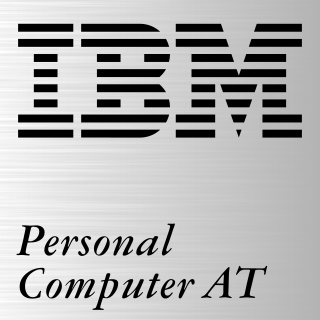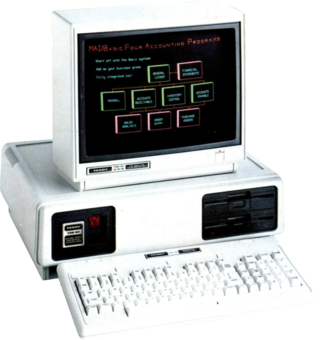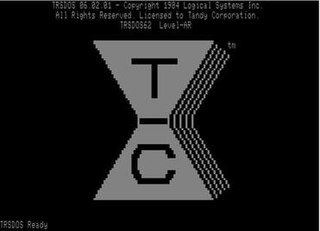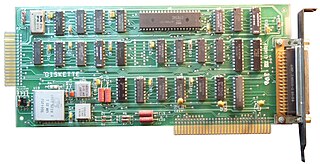
A floppy disk or floppy diskette is a type of disk storage composed of a thin and flexible disk of a magnetic storage medium in a square or nearly square plastic enclosure lined with a fabric that removes dust particles from the spinning disk. The three most popular floppy disks are the 8-inch, 5¼-inch, and 3½-inch floppy disks. Floppy disks store digital data which can be read and written when the disk is inserted into a floppy disk drive (FDD) connected to or inside a computer or other device.

The TRS-80 Micro Computer System is a desktop microcomputer launched in 1977 and sold by Tandy Corporation through their Radio Shack stores. The name is an abbreviation of Tandy Radio Shack, Z80 [microprocessor]. It is one of the earliest mass-produced and mass-marketed retail home computers.

Shugart Associates was a computer peripheral manufacturer that dominated the floppy disk drive market in the late 1970s and is famous for introducing the 5+1⁄4-inch "Minifloppy" floppy disk drive. In 1979 it was one of the first companies to introduce a hard disk drive form factor compatible with a floppy disk drive, the SA1000 form factor compatible with the 8-inch floppy drive form factor.

The IBM Personal Computer AT was released in 1984 as the fourth model in the IBM Personal Computer line, following the IBM PC/XT and its IBM Portable PC variant. It was designed around the Intel 80286 microprocessor.
In computer science, group coded recording or group code recording (GCR) refers to several distinct but related encoding methods for representing data on magnetic media. The first, used in 6250 bpi magnetic tape since 1973, is an error-correcting code combined with a run-length limited (RLL) encoding scheme, belonging into the group of modulation codes. The others are similar encoding methods used in mainframe hard disks or microcomputer floppy disks until the late 1980s. GCR is a modified form of a NRZI code, but necessarily with a higher transition density.

A magneto-optical drive is a kind of optical disc drive capable of writing and rewriting data upon a magneto-optical disc. 130 mm (5.25 in) and 90 mm (3.5 in) discs were the most common sizes. In 1983, just a year after the introduction of the compact disc, Kees Schouhamer Immink and Joseph Braat presented the first experiments with erasable magneto-optical compact discs during the 73rd AES Convention in Eindhoven. The technology was introduced commercially in 1985. Although optical, they normally appear as hard disk drives to an operating system and can be formatted with any file system. Magneto-optical drives were common in some countries, such as Japan, but have fallen into disuse.

The Tandy 2000 is a personal computer introduced by Radio Shack in September 1983 based on the 8 MHz Intel 80186 microprocessor running MS-DOS. By comparison, the IBM PC XT used the older 4.77 MHz Intel 8088 processor, and the IBM PC/AT would later use the newer 6 MHz Intel 80286. Due to the 16-bit data bus and more efficient instruction decoding of the 80186, the Tandy 2000 ran significantly faster than other PC compatibles, and slightly faster than the PC AT. The Tandy 2000 was the company's first computer built around an Intel x86 series microprocessor; previous models used the Zilog Z80 and Motorola 6809 CPUs.

TRSDOS is the operating system for the Tandy TRS-80 line of eight-bit Zilog Z80 microcomputers that were sold through Radio Shack from 1977 through 1991. Tandy's manuals recommended that it be pronounced triss-doss. TRSDOS should not be confused with Tandy DOS, a version of MS-DOS licensed from Microsoft for Tandy's x86 line of personal computers (PCs).
Each generation of floppy disk drive (FDD) began with a variety of incompatible interfaces but soon evolved into one de facto standard interface for the generations of 8-inch FDDs, 5.25-inch FDDs and 3.5-inch FDDs. For example, before adopting 3.5-inch FDD standards for interface, media and form factor there were drives and media proposed by Hitachi, Tabor, Sony, Tandon, Shugart and Canon.

Compaq's first computers' form factors were portable, also called "luggables", and then "lunchbox computers", and together constituted the Compaq Portable series. These computers measured approximately 16 inches (410 mm) deep, 8 inches (200 mm) tall, and approximately 20 inches (510 mm) wide. As the products evolved, laptops and notebooks were created offing a new level of portability that caused the market to explode.
Micropolis Corporation was a disk drive company located in Chatsworth, California and founded in 1976. Micropolis initially manufactured high capacity hard-sectored 5.25-inch floppy drives and controllers, later manufacturing hard drives using SCSI and ESDI interfaces.

A floppy-disk controller (FDC) is a hardware component that directs and controls reading from and writing to a computer's floppy disk drive (FDD). It has evolved from a discrete set of components on one or more circuit boards to a special-purpose integrated circuit or a component thereof. An FDC is responsible for reading data presented from the host computer and converting it to the drive's on-disk format using one of a number of encoding schemes, like FM encoding or MFM encoding, and reading those formats and returning it to its original binary values.

The Disk II Floppy Disk Subsystem, often rendered as Disk ][, is a 5 +1⁄4-inch floppy disk drive designed by Steve Wozniak at the recommendation of Mike Markkula, and manufactured by Apple Computer It went on sale in June 1978 at a retail price of US$495 for pre-order; it was later sold for $595 including the controller card and cable. The Disk II was designed specifically for use with the 1977 Apple II personal computer to replace the slower cassette tape storage.

Irwin Magnetic Systems, Inc., also known as Irwin Magnetics, was a computer storage manufacturer active from 1979 to 1989 and based in Ann Arbor, Michigan. It was founded by Samuel Irwin in 1979 as Irwin International, Inc. The company's primary export was magnetic tape data storage and backup systems for personal computers. Irwin was one of the first companies to manufacture quarter-inch cartridge (QIC) systems for the personal computer market. In 1989, the company was acquired by Cipher Data Products.

FileWare floppy disk drives and diskettes were designed by Apple Computer as a higher-performance alternative to the Disk II and Disk III floppy systems used on the Apple II and Apple III personal computers. The drive is named Apple 871 in service documentation, based on its approximate formatted storage capacity in kilobytes, but is most commonly known by their codename Twiggy, after the famously thin 1960s fashion model named Twiggy.

A floppy disk is a disk storage medium composed of a thin and flexible magnetic storage medium encased in a rectangular plastic carrier. It is read and written using a floppy disk drive (FDD). Floppy disks were an almost universal data format from the 1970s into the 1990s, used for primary data storage as well as for backup and data transfers between computers.

The TRS-80 Model II is a computer system launched by Tandy in October 1979, and targeted at the small-business market. It is not an upgrade of the original TRS-80 Model I, but a new system.

The floppy disk is a data storage and transfer medium that was ubiquitous from the mid-1970s well into the 2000s. Besides the 3½-inch and 5¼-inch formats used in IBM PC compatible systems, or the 8-inch format that preceded them, many proprietary floppy disk formats were developed, either using a different disk design or special layout and encoding methods for the data held on the disk.
Sirjang Lal Tandon also known as "Jugi" Tandon, was born in India c. 1942. He is chairman and CEO of Celetronix, Inc. He is known for leading his company, Tandon Corporation in the disk drive industry, creating what became the industry-standard double-sided floppy drive disk read-and-write heads.
PolyMorphic Systems was a manufacturer of microcomputer boards and systems based on the S-100 bus. Their products included the Poly-88 and the System 8813. The company was incorporated in California in 1976 as Interactive Products Corporation d/b/a PolyMorphic Systems. It was initially based in Goleta, then Santa Barbara, California.













